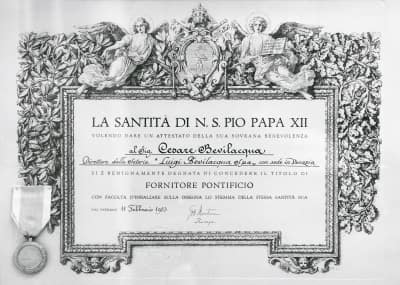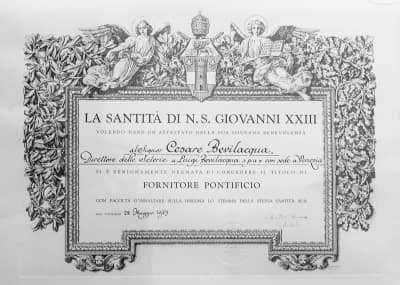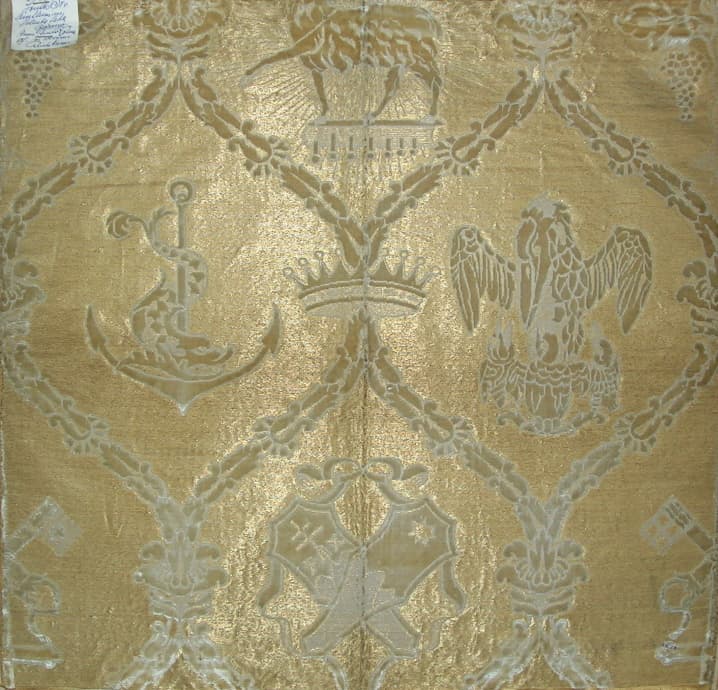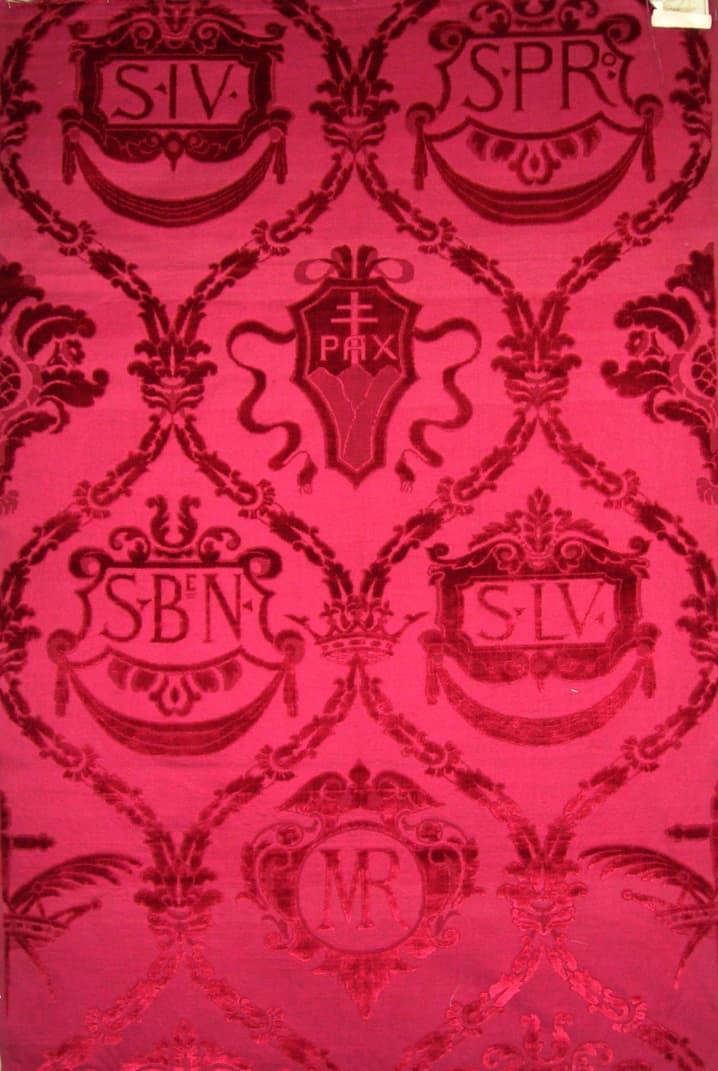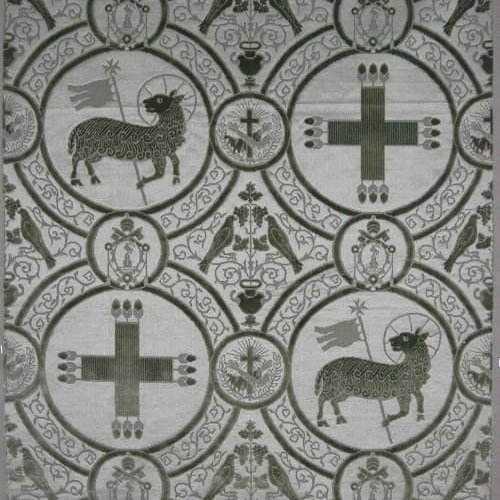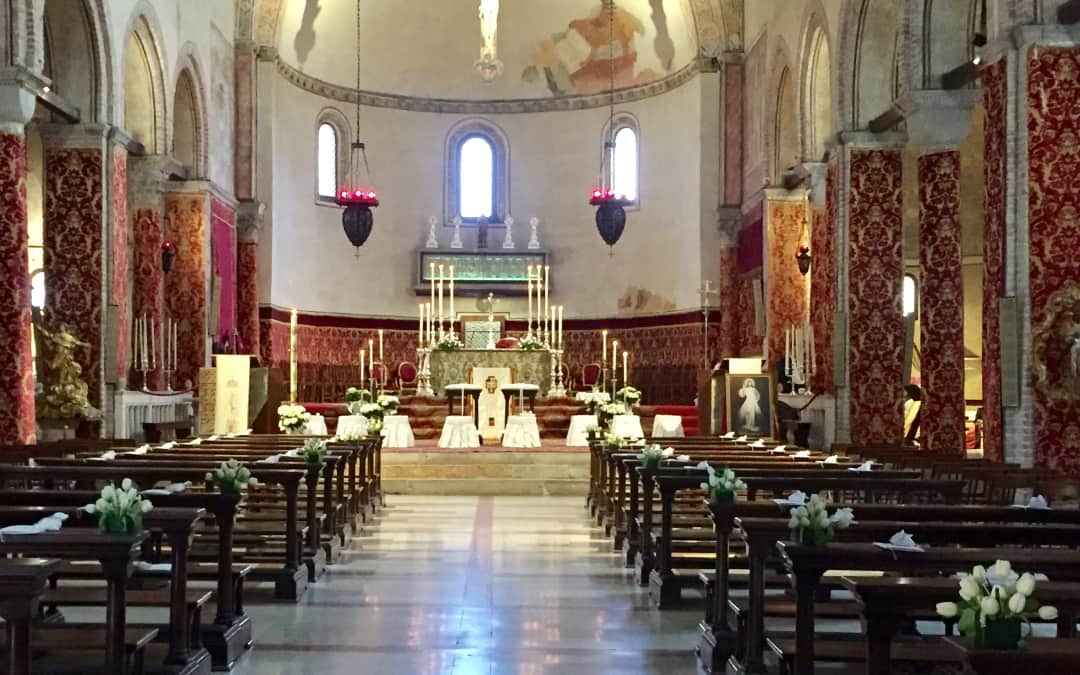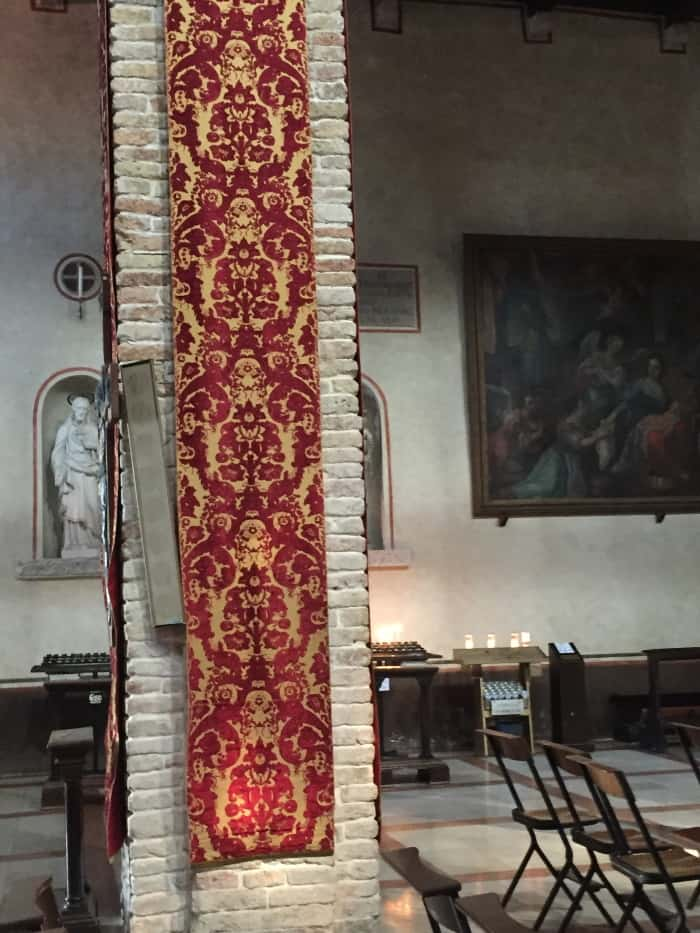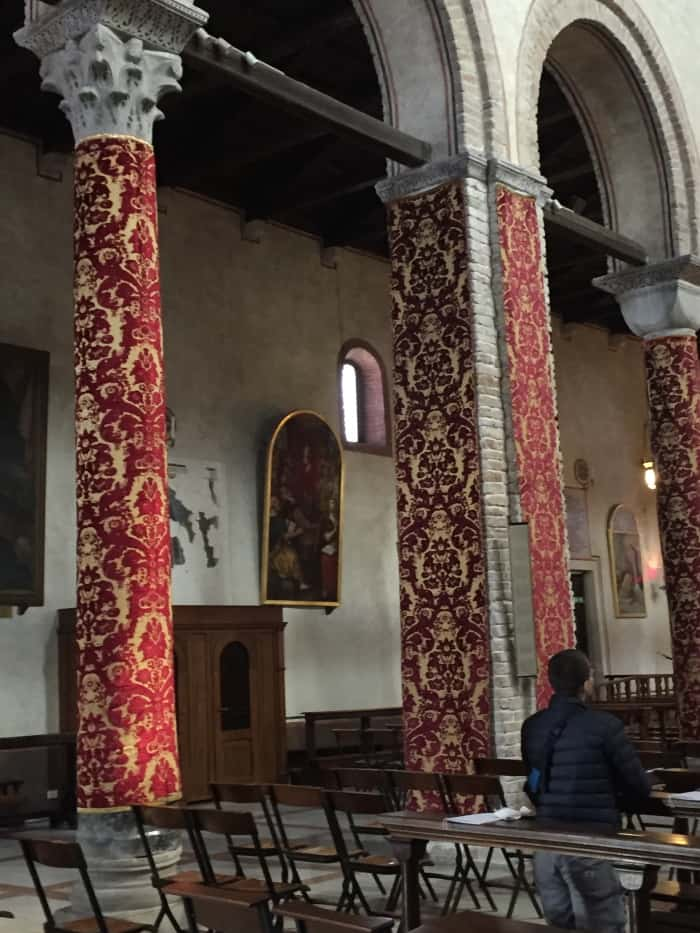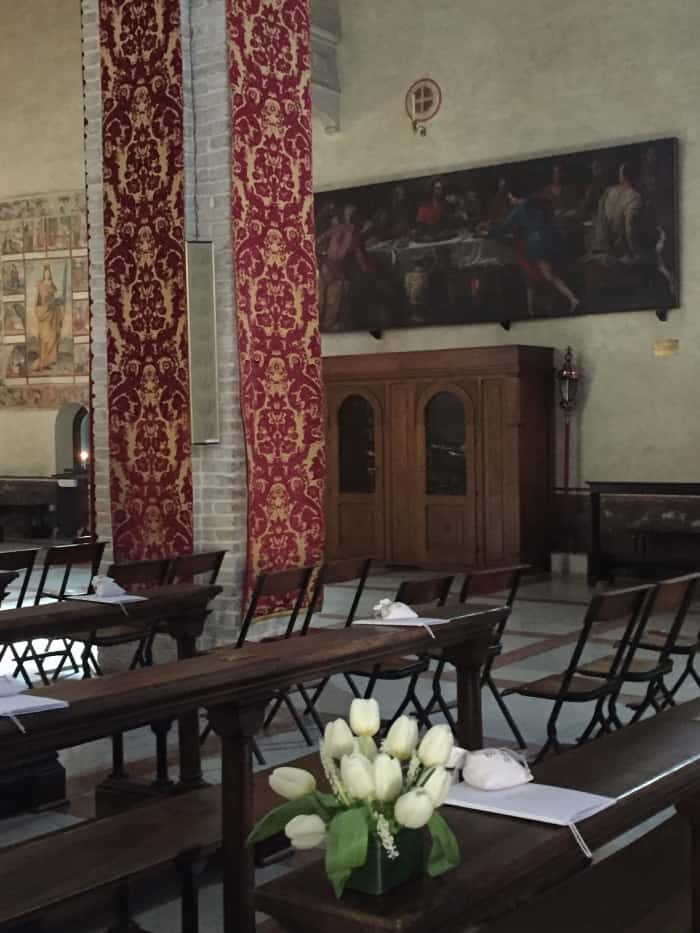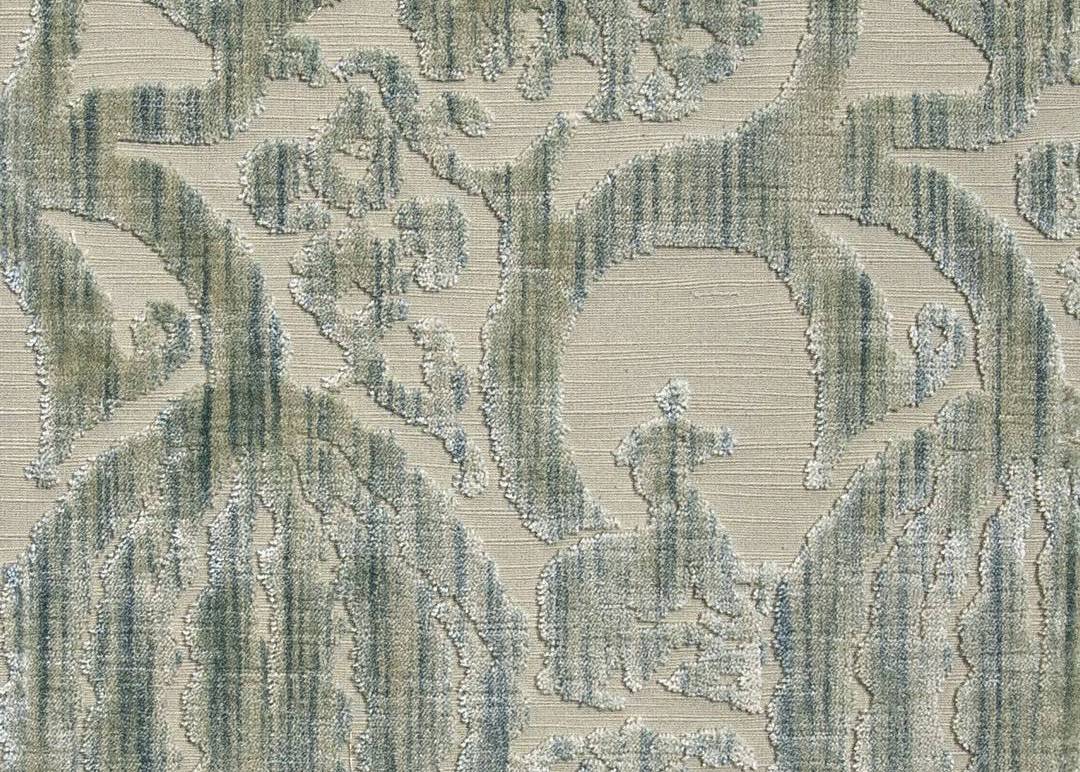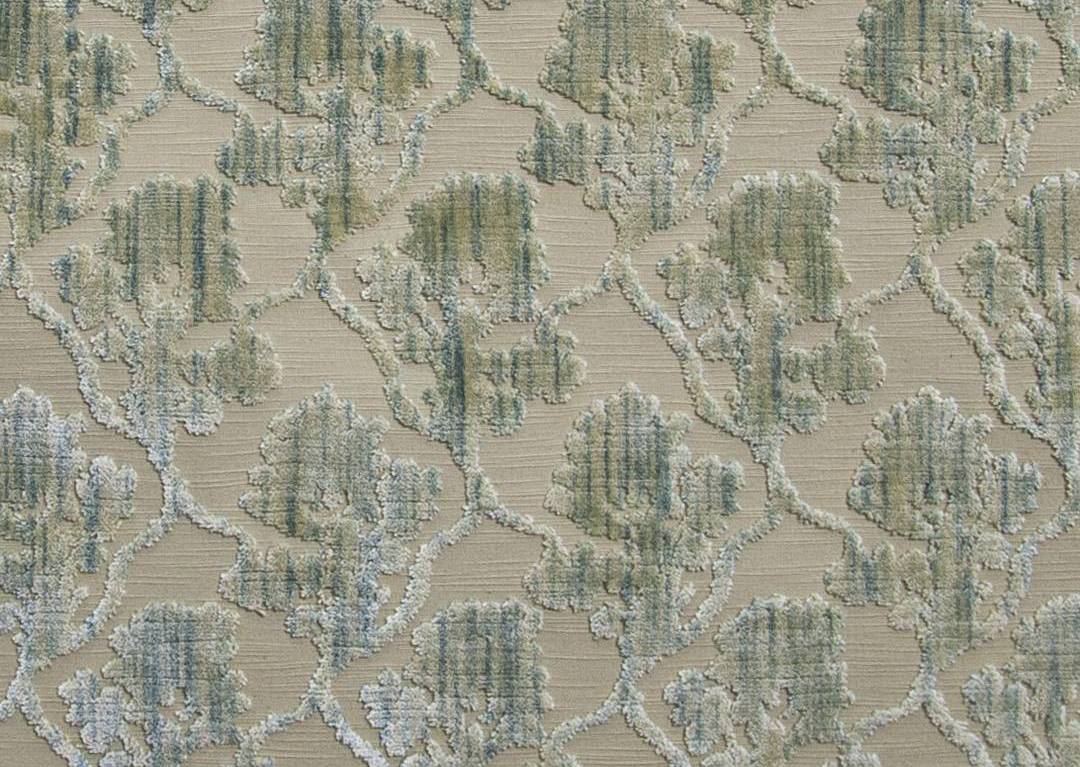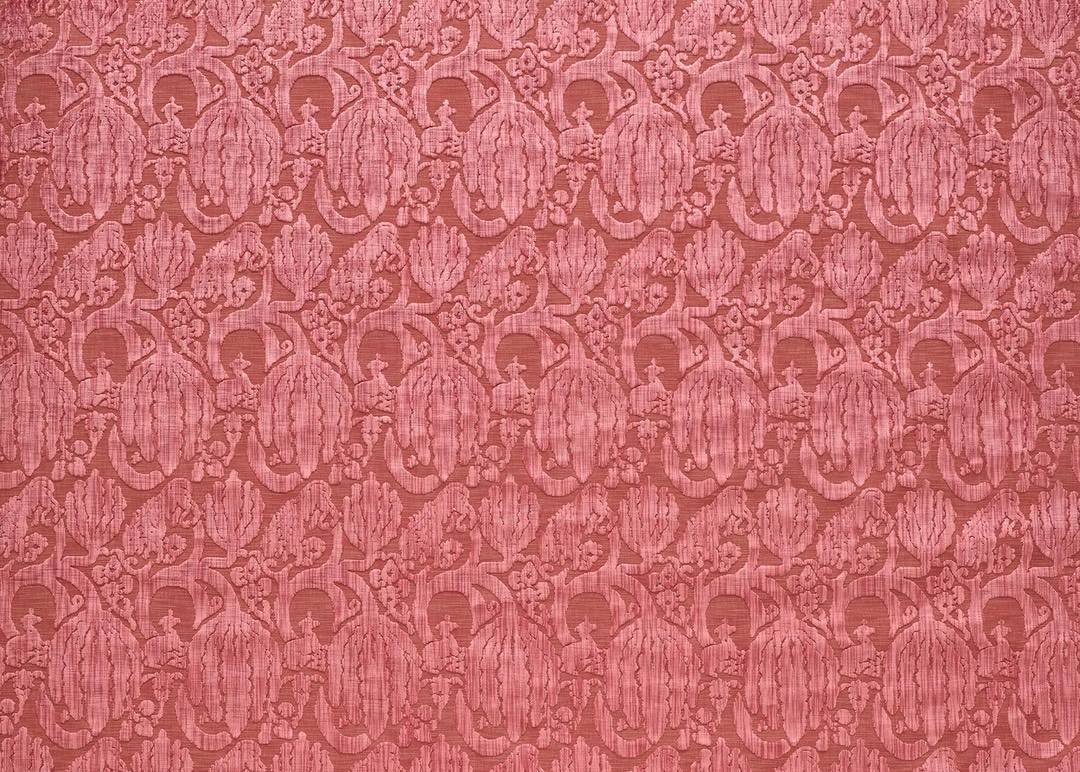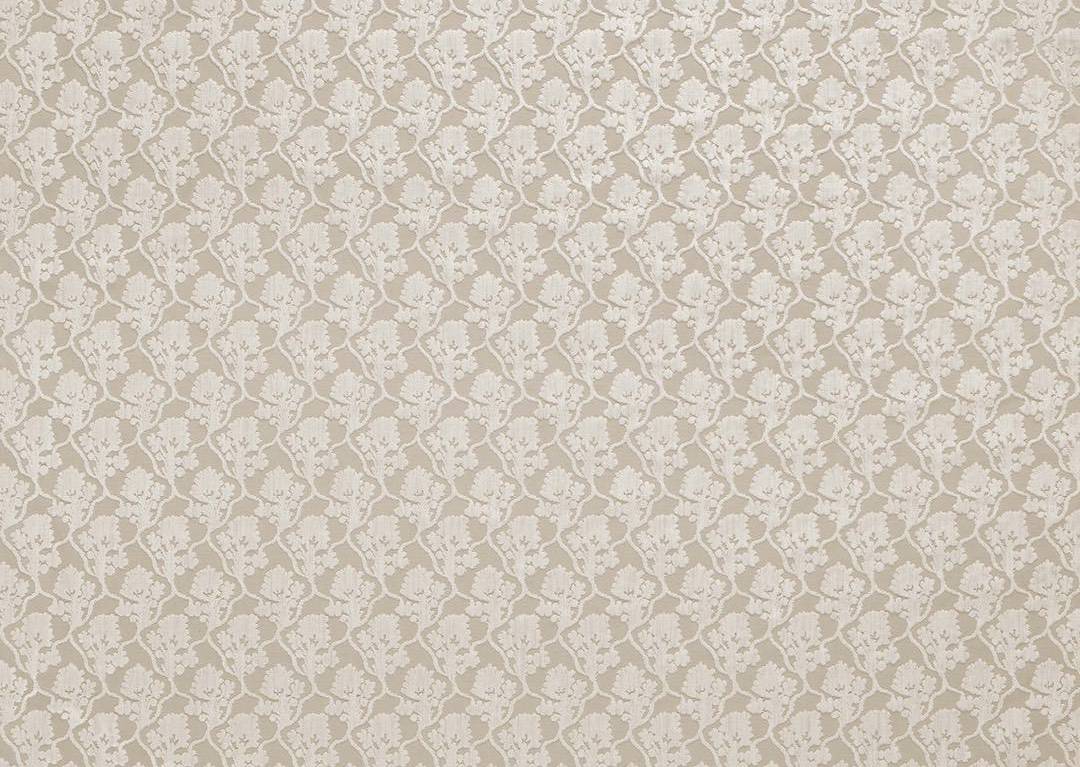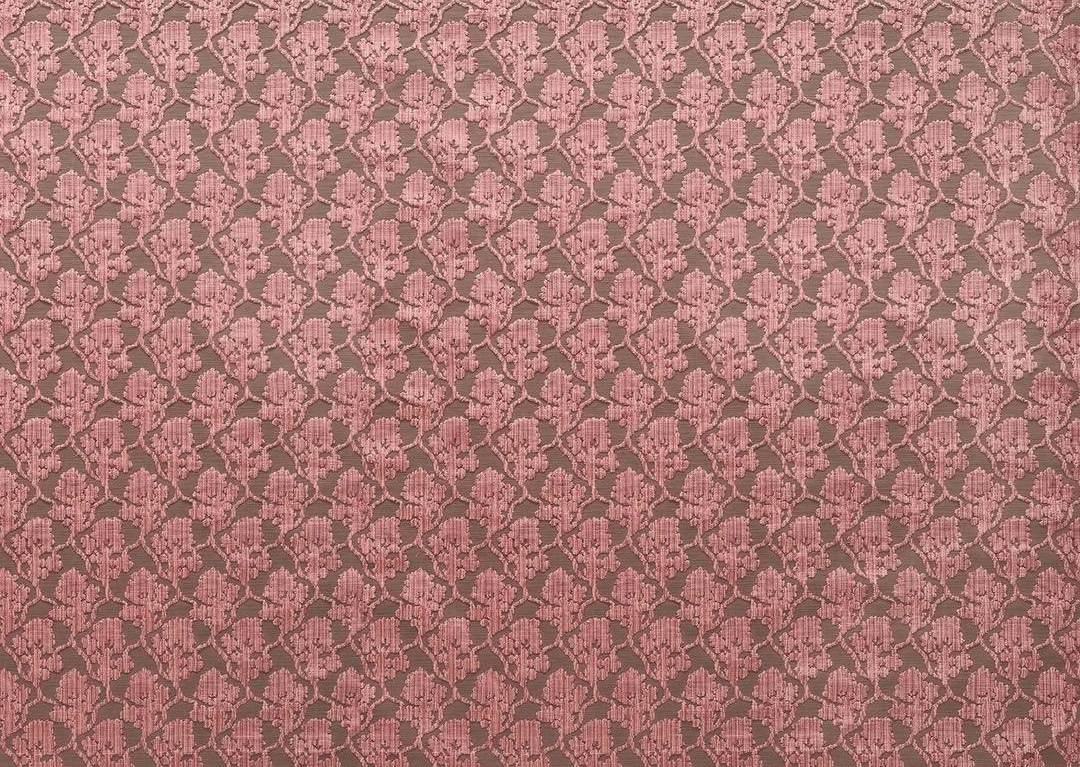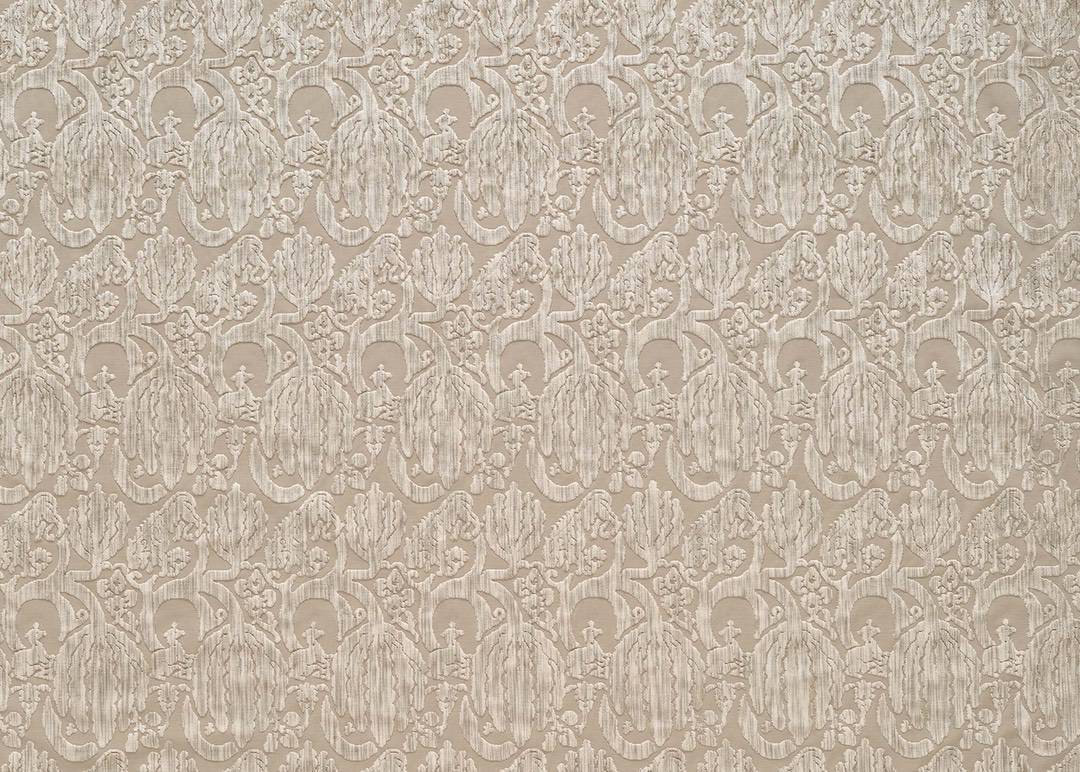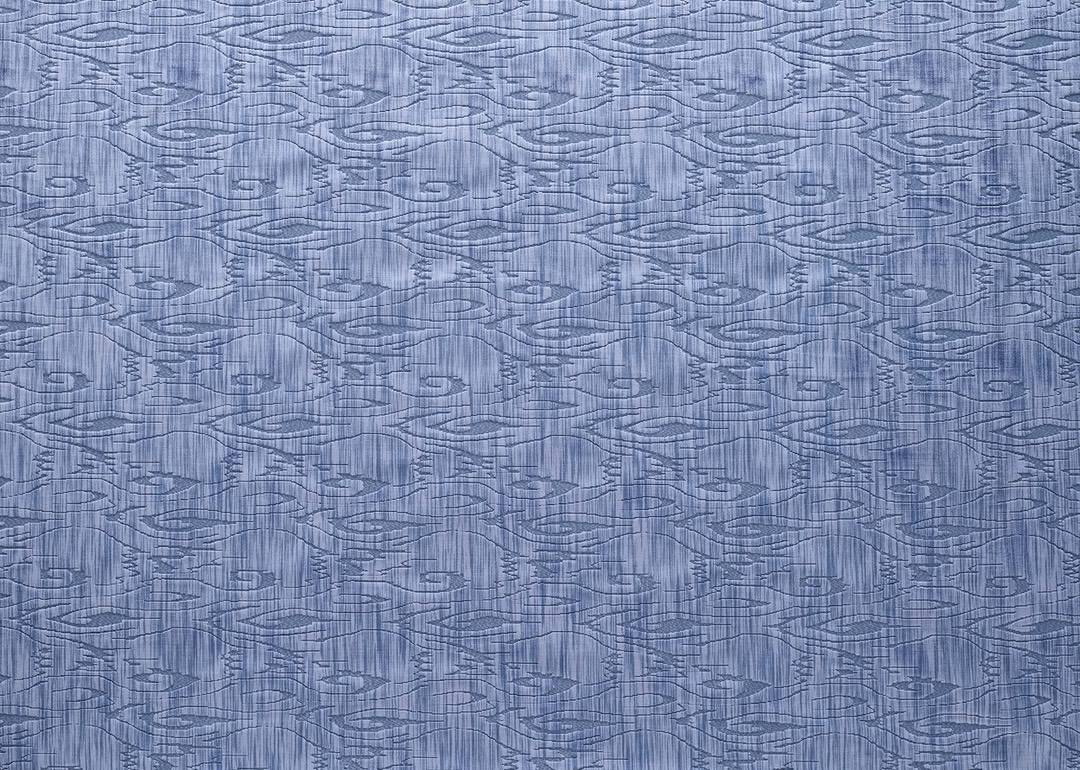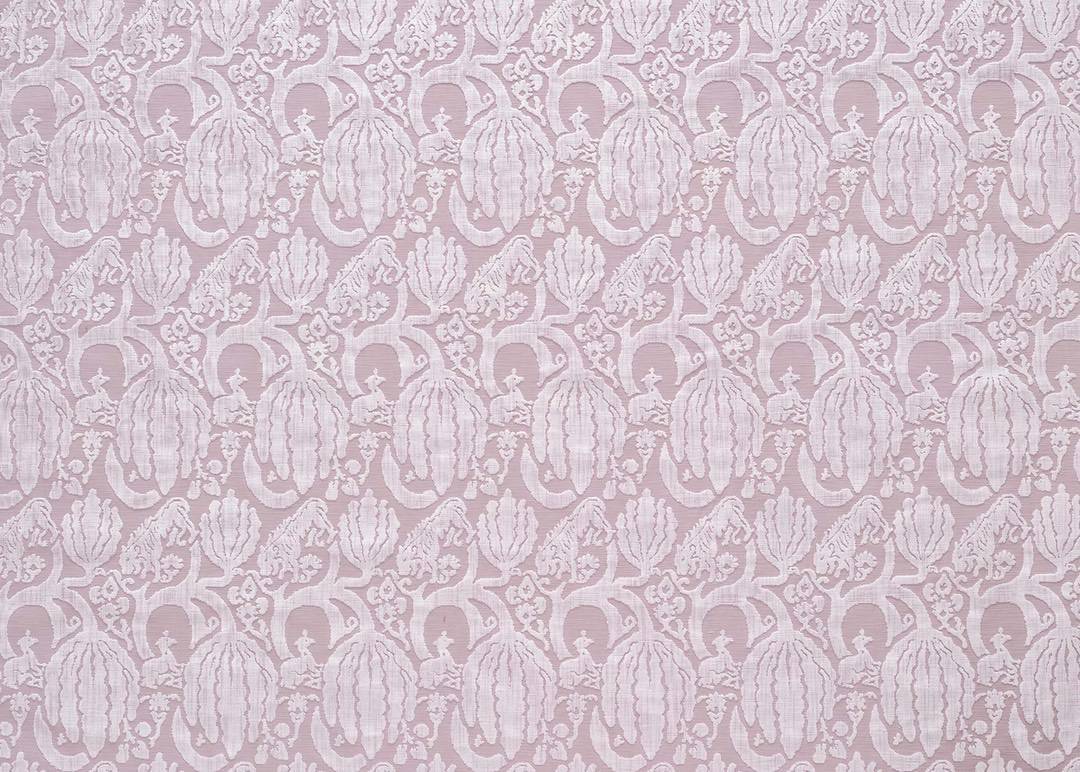At the beginning of the 20th century, our Tessitura was awarded a series of important recognitions. Among these were the gold medal at the Brussels Universal Exposition in 1910 and the Grand Prize at the International Exposition of Turin in 1928.
As a result of these awards and the fame gained, fruitful collaborations were born with the Church for the supply of fabrics for both liturgical furnishings and vestments.
Churches, basilicas, convents, and the Vatican itself were embellished with velvets and other precious fabrics by Bevilacqua, to the extent that in 1953 we obtained the title of “papal supplier” from Pope Pius XII and, in 1959, from Pope John XXIII.
The iconographic motifs are taken from the past and often mixed in a so-called eclecticism of styles. Byzantine, Gothic, Renaissance, Baroque, and Neoclassical designs enter the sacred furnishings, including elements which are typical of early Christian symbolism. We still preserve, in our historical archive, samples of these fabrics, each one rich in history and beauty.
Soprarizzo Velvet for the Abbey of Praglia
For the Benedictine monks of the Abbey of Praglia, in the environs of Padua, in 1934 we created a precious silk soprarizzo velvet in ivory color on a gold ground. The decoration, with a 16th-century compositional structure, is filled with traditional elements from the Eucharistic liturgy, harmoniously combined with the coats of arms that identify the patron:
- a radiant Paschal lamb represents Jesus in his sacrificial role;
- bunches of grapes symbolize the blood of Christ;
- an anchor, meaning the firm certainty of faith, with the dolphin, a symbol of salvation because it was believed that dolphins saved sailors from shipwrecks, bringing them up to the surface to let them breathe;
- the Eucharistic pelican is the allegory of Christ’s supreme sacrifice because there was the erroneous belief that adult pelicans tore their chests to feed their chicks with their blood. This reminds us of the blood which came out of the wound on crucified Jesus’s side, seen as a source of life for mankind;
- the papal keys, the symbol of Saint Peter, the first pope, because he was entrusted the keys to Heaven;
- two crossed shields, one bearing the double cross, the inscription PAX and three mountains, the symbol of the Benedictine order, and the other with a seven-pointed star, the symbol of the Abbey.
A chasuble (the vestment worn by the religious man celebrating mass) made with this velvet was displayed at the International Exhibition of Sacred Art held in Rome in 1934.
Soprarizzo Velvet for the Basilica of Santa Giustina in Padua
For the Benedictine monks of Santa Giustina church in Padua, is another soprarizzo velvet in crimson silk, created for the presbytery of the basilica in 1934. The mesh compositional structure, given by stems of leaves and pomegranate flowers, enclose the initials of saints venerated in the church. They appear as if carved in relief.
Thus we read the letters “S.IV” referring to St. Giustina, “S.PR⁰” for St. Prosdocimo and “S.LU”, St. Luke the Evangelist. Note also the initials of St. Benedict Abbot, “S.BeN”, founder of the order and the monogram MR, referring to Our Lady. You can also recognize the shield with the double cross, the three mountains and the inscription PAX, the symbol of the Benedictine order.
Vestments for the Greek Pontifical College
This soprarizzo velvet in olive green silk was commissioned for the vestments of the Greek Pontifical College of Rome in the 1930s. Heraldic and early Christian symbols are inserted on a circular structure, of Medieval inspiration.
Besides the lamb, a symbol of Christ, there is a Greek cross whose arms end with three acorns. Inside the smaller roundels, you can see the coat of arms of Pope Pius XII (1939-1958), who commissioned the fabric, with the papal tiara and keys.
As well as the Franciscan heraldic emblem, with two crossed arms from which stands a Latin cross. The naked arm belongs to Christ while the one dressed in a habit is St. Francis’s. Its meaning is the conformity of Saint Francis to Christ. In the spaces delimited by the circles we can see two doves feeding on bunches of grapes, an expression of the soul that has entered into God’s peace and participates in the eternal banquet. They are surrounded by branches, indicating the universal Church.
Other Precious Bevilacqua Fabrics in Italian Churches
There are numerous other examples of fabrics created for the Church that can still be admired today. In Venice, the magnificent soprarizzo velvets of the basilica of the Madonna della Salute in red and gold with rococo floral motifs; the splendid multicolored velvets of the church of San Zulian, characterized by an explosion of naturalistic elements typical of the “Jardinière” motifs; and the soprarizzo velvet with a giant sunflower of the church of Sant’Alvise.
The Cathedral of Caorle, a delightful coastal town in the province of Venice, also boasts handwoven velvets, made in the early 40s. It is the soprarizzo “Fioroni”, in shades of red and gold with floral elements of baroque inspiration, another example of Jardiniére pattern that spread in the 17th century, when weaving techniques allowed for the creation of motifs extremely rich in details and colors and that today also adorn Italian churches.
Cathedral of Caorle – Image Gallery
The Basilica of Santa Maria Maggiore in Bergamo treasures one of our velvets too. This splendid church, whose construction began in 1137 and features Romanesque structures and Baroque overlays, is adorned with red velvet drapes on the antependium of the main altar and on the two side pulpits during the Christmas season celebrations. This velvet is called Leoni Bizantini and the color is pomegranate. The motif of this fabric depicts two lions guarding the tree of life, a symbol that spans many religions and cultures. The presence of this velvet reflects the connection between the Basilica of Santa Maria Maggiore and Venice. Venetian art and textiles are well incorporated into the artistic and liturgical context of the basilica.
Basilica of Santa Maria Maggiore in Bergamo – Image Gallery
Cover Photo: Basilica of Santa Maria Maggiore - Bergamo, Italy


